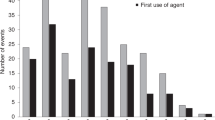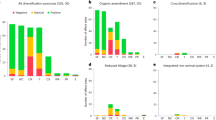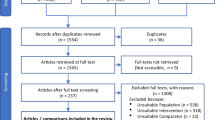Abstract
Global food security requires increased crop productivity to meet escalating demand1–3. Current food production systems are heavily dependent on synthetic inputs that threaten the environment and human well-being2,4,5. Biodiversity, for instance, is key to the provision of ecosystem services such as pest control6,7, but is eroded in conventional agricultural systems. Yet the conservation and reinstatement of biodiversity is challenging5,8,9, and it remains unclear whether the promotion of biodiversity can reduce reliance on inputs without penalizing yields on a regional scale. Here we present results from multi-site field studies replicated in Thailand, China and Vietnam over a period of four years, in which we grew nectar-producing plants around rice fields, and monitored levels of pest infestation, insecticide use and yields. Compiling the data from all sites, we report that this inexpensive intervention significantly reduced populations of two key pests, reduced insecticide applications by 70%, increased grain yields by 5% and delivered an economic advantage of 7.5%. Additional field studies showed that predators and parasitoids of the main rice pests, together with detritivores, were more abundant in the presence of nectar-producing plants. We conclude that a simple diversification approach, in this case the growth of nectar-producing plants, can contribute to the ecological intensification of agricultural systems.
This is a preview of subscription content, access via your institution
Access options
Subscribe to this journal
Receive 12 digital issues and online access to articles
$119.00 per year
only $9.92 per issue
Buy this article
- Purchase on SpringerLink
- Instant access to full article PDF
Prices may be subject to local taxes which are calculated during checkout



Similar content being viewed by others
References
Godfray, H. C. & Garnett, T. Food security and sustainable intensification. Phil. Trans. R. Soc. B. 369, 20120273 (2014).
West, P. C. et al. Leverage points for improving global food security and the environment. Science 345, 325–328 (2014).
Tilman, D., Balzer, C., Hill, J. & Befort, B. L. Global food demand and the sustainable intensification of agriculture. Proc. Natl Acad. Sci. USA 108, 20260–20264 (2011).
Stehle, S. & Schulz, R. Agricultural insecticides threaten surface waters at the global scale. Proc. Natl Acad. Sci. USA 112, 5750–5755 (2015).
Foley, J. A. et al. Global consequences of land use. Science 309, 570–574 (2005).
Costanza, R. et al. The value of the world's ecosystem services and natural capital. Nature 387, 253–260 (1997).
Losey, J. E. & Vaughan, M. The economic value of ecological services provided by insects. Bioscience 56, 311–323 (2006).
Matson, P. A., Parton, W. J., Power, A. G. & Swift, M. J. Agricultural intensification and ecosystem properties. Science 277, 504–509 (1997).
Bennett, E. et al. Toward a more resilient agriculture. Solutions 5, 65–75 (2014).
Phalan, B., Onial, M., Balmford, A. & Green, R. E. Reconciling food production and biodiversity conservation: land sharing and land sparing compared. Science 333, 1289–1291 (2011).
Foley, J. A. et al. Solutions for a cultivated planet. Nature 478, 337–342 (2011).
Gill, R. J., Ramos-Rodriguez, O. & Raine, N. E. Combined pesticide exposure severely affects individual- and colony-level traits in bees. Nature 491, 105–108 (2012).
Diaz, R. J. & Rosenberg, R. Spreading dead zones and consequences for marine ecosystems. Science 321, 926–929 (2008).
Eskenazi, B. et al. Organophosphate pesticide exposure and neurodevelopment in young Mexican-American children. Environ. Health Persp. 115, 792–798 (2007).
Loos, J. et al. Putting meaning back into “sustainable intensification”. Front. Ecol. Environ. 12, 356–361 (2014).
Cardinale, B. J. et al. Effects of biodiversity on the functioning of trophic groups and ecosystems. Nature 443, 989–992 (2006).
Bommarco, R., Kleijn, D. & Potts, S. G. Ecological intensification: harnessing ecosystem services for food security. Trends Ecol. Evol. 28, 230–238 (2013).
Wood, S. A. et al. Functional traits in agriculture: agrobiodiversity and ecosystem services. Trends Ecol. Evol. 30, 531–539 (2015).
Ekroos, J., Olsson, O., Rundlöf, M., Wätzold, F. & Smith, H. G. Optimizing agri-environment schemes for biodiversity, ecosystem services or both? Biol. Conserv. 172, 65–71 (2014).
Letourneau, D. K. et al. Does plant diversity benefit agroecosystems? A synthetic review. Ecol. Appl. 21, 9–21 (2011).
Pretty, J. N. et al. Resource-conserving agriculture increases yields in developing countries. Environ. Sci. Technol. 40, 1114–1119 (2006).
Khan, Z. R. et al. Exploiting chemical ecology and species diversity: stem borer and striga control for maize and sorghum in Africa. Pest Manag. Sci. 56, 957–962 (2000).
Crowder, D. W., Northfield, T. D., Strand, M. R. & Snyder, W. E. Organic agriculture promotes evenness and natural pest control. Nature 466, 109–112 (2010).
Seufert, V., Ramankutty, N. & Foley, J. A. Comparing the yields of organic and conventional agriculture. Nature 485, 229–232 (2012).
Kremen, C. & Miles, A. Ecosystem services in biologically diversified versus conventional farming systems: benefits, externalities, and trade-offs. Ecol. Soc. 17, 40 (2012).
Luck, G. W. et al. Quantifying the contribution of organisms to the provision of ecosystem services. Bioscience 59, 223–235 (2009).
Wäckers, F. L., Romeis, J. & van Rijn, P. Nectar and pollen feeding by insect herbivores and implications for multitrophic interactions. Annu. Rev. Entomol. 52, 301–323 (2007).
Zhu, P. et al. Laboratory screening supports the selection of sesame (Sesamum indicum) to enhance Anagrus spp. parasitoids (Hymenoptera: Mymaridae) of rice planthoppers. Biol. Control 64, 83–89 (2013).
Liu, Z. et al. A nicotinic acetylcholine receptor mutation conferring target-site resistance to imidacloprid in Nilaparvata lugens (brown planthopper). Proc. Natl Acad. Sci. USA 102, 8420–8425 (2005).
Czaja, K. et al. Biopesticides—towards increased consumer safety in the European Union. Pest Manag. Sci. 71, 3–6 (2015).
Acknowledgements
This work was supported by the Asian Development Bank (TA7648-R-RDTA) and National Basic Research Program of China (973, grant no. 2010CB126200). G.M.G. is supported by a Chinese Government Thousand Talents fellowship. We thank the farmers who hosted field experiments and J. Tylianakis (Christchurch University, New Zealand) for comments on this manuscript. Assistance with arthropod sorting and taxonomy was provided by Y. Yang, G. Wenqin, L. Ding and D. Biqing of Zhejiang Academy of Agricultural Sciences, and F. Zhang and X. Sheng of Jianhua Plant Protection Station, China.
Author information
Authors and Affiliations
Contributions
G.M.G. and K.L.H. conceived and designed the project; Z.L., Z.Z., J.C. and G.C. led the Chinese studies supported by X.Z., X.Y., H.X. and P.Z.; H.V.C. and L.Q.C. led the Vietnamese studies; C.C. led the Thai studies; N.C. and P.Z. performed the bait plant study; and P.Z. and X.Z. performed the factorial study; P.V., J.L.C., L.P.L., J.C. and S.V. identified arthropods; H.I.N., D.J.P. and G.M.G. analysed the data; G.M.G. led the manuscript writing with input from all authors.
Corresponding author
Ethics declarations
Competing interests
The authors declare no competing financial interests.
Supplementary information
Rights and permissions
About this article
Cite this article
Gurr, G., Lu, Z., Zheng, X. et al. Multi-country evidence that crop diversification promotes ecological intensification of agriculture. Nature Plants 2, 16014 (2016). https://doi.org/10.1038/nplants.2016.14
Received:
Accepted:
Published:
DOI: https://doi.org/10.1038/nplants.2016.14




